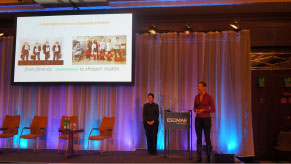Jonatan Hedin
Venice, the location of this year’s qualitative ESOMAR conference, is a city on the water, with seasonal and ever more frequent floods. This is becoming a nuisance to the population, and a threat to the generally flourishing tourism. Whether the problem originates from the wooden piles that carry the city sinking into the mud beneath, or because the sea level is rising seems debated among the locals.Much like Venice’s streets, the qualitative research business has been on a slow decline for the past couple of years, according to figures in ESOMARs yearly industry report ‘Global market research’. The world’s leading qualitative research methods conference, ESOMAR Global Qualitative, clearly took its starting point in this observation this time. The first day’s concluding panel session asked “Is qualitative research undergoing a revolution or barely adapting to a new market situation?”This was the somewhat forlorn starting point of the conference, but looking at the rich list of speakers, it seems that plenty of new wooden piles are emerging to underpin the industry’s foundation.
New recruiting possibilities
Can blind people bring unique insight to product development at a global cosmetics and beauty company? Runa Gupta of L’Oreal India together with her consultants from Firefly Millward Brown India displayed a powerful case where they employed visually impaired participants in texture and stickiness tests of new cosmetic substances, an area where regular participants often become victims to visual bias.
 Reinvented research methods that draw on new technology and participant engagement
Reinvented research methods that draw on new technology and participant engagement
Can police questioning methods increase supermarket shopper understanding? Christiane Schmitz-Trebeljahr of Séissmo Germany and Ruthie Brandman of Brandman research presented a commercial application of an interview technique developed by forensic psychologists in the 1980s. The underlying idea is in the example of a car accident not to ask “which color was the car?”, a situation in which respondents who can’t recall simply make up an answer. Instead, researchers should ask respondents to divide the accident in different episodes, and then describe episode by episode in as much detail as possible. This allows the interviewee to access the episodic memory and analyse past behaviour in the way it was ‘recorded’. When the couple or family is getting together in the living room to watch X-factor together on a weekend night, a researcher in the room can potentially alter their behaviour. This, and the cost of putting researchers in twenty homes on weekend evenings, made Craft and ITV of the UK conduct their ethnographic study of how people used the X-factor app while watching the TV show with the help of eyecams. This led to a number of changes, both to the app and the TV show, driven by observing how families naturally interact around the situation.
 Presentation formats that talk to consumers and get the boards’ attention
Presentation formats that talk to consumers and get the boards’ attention
When customers can’t listen in on focus groups, join researchers on consumer safaris or partake in other qualitative research, the need for effective presentation methods increase. “The cat sat on the mat” is not the beginning of a story, “The cat sat on the dog’s mat” is. Martin Lee of Acacia Avenue, UK emphasised conflict as a vital part of narrating qualitative research insights so that they become interesting to an audience with short attention spans.How can the vast amounts of material created during a research project be utilised, after conclusions are drawn and insights delivered? Steve Hill of Jaguar and Land Rover, and Rhiannon Price of Northstar Research, UK presented a case, where videos of interviews with 4×4-vehicle owners was reused as footage in a book adapted for a broader audience, explaining how Land Rovers are used around the world.Plenty of cases were presented throughout the conference’s first day, and if one conclusion is to be drawn, it is that there are plenty of new, applied and value-creating methods out there to power the qualitative research industry in the years to come.
Jonatan Hedin is an Analyst at the Confederation of Swedish Enterprise
@jonatanhedin


